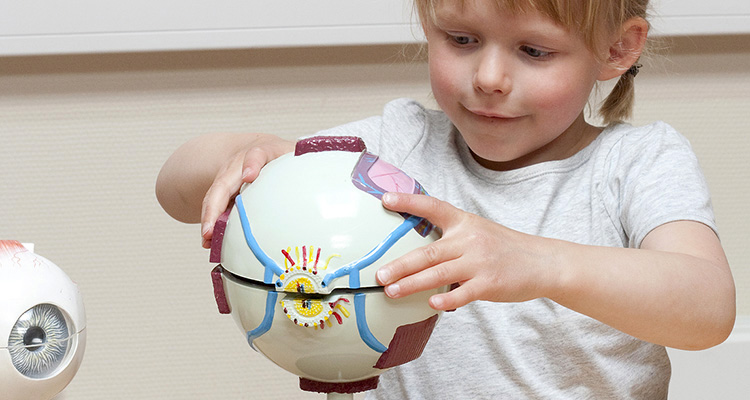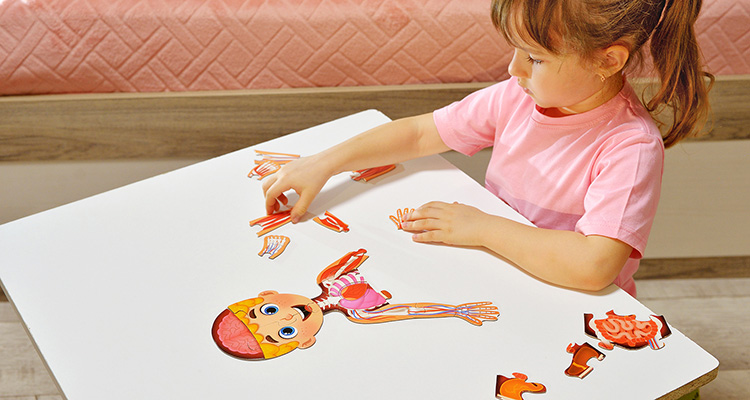Cutting out crafts, learning how to swing, potty training, and many other early childhood activities center around mastering the body. Most adults can perform these actions without thinking because we’ve achieved automaticity. Young children have to work on developing their mind-body connection. Automaticity is a goal of early childhood development. When your little one has a strong mind-body connection, it’s easier for them to tackle tougher skills like reading, writing, and counting. Teaching your child about their body helps them master it and develop a healthy appreciation for it.
Teach Them Language for Their Body
Young children are often fascinated by their bodies. Identifying their body parts gives them language to communicate about it and strengthens their mind-body connection. When you teach them about their genitals, child psychologists stress the importance of using the correct anatomical names instead of euphemistic nicknames. According to RAACE, “Using the correct anatomical name for all parts of the body helps your children build a positive body image and opens the door for an honest, open dialogue with you on any questions they have about their bodies or sexuality.” There are many natural opportunities to teach children the names of body parts, from bath time to singing “Heads, shoulders, knees and toes” at bedtime. Creating a life-size anatomy model with paper is a fun way to educate them about critical internal systems like bones, muscles, and organs. Or you can use these free printable mats to make bones, muscles, and organs out of Play-Doh together.
Explore How Bones & Muscles Work
Understanding how internal parts of their bodies work takes imagination. Teaching your kid about their bones and muscles is a great place to start. You can begin the conversation about bones by having them feel the bones in their fingers and the vertebrae in your back or their siblings when you bend down. Then explain how bones are the underlying structure in our body that holds us up. To start a conversation about muscles, flex your arm and have them feel the muscle. Explain how muscles make our bones move and help us perform small and large tasks, from picking up a pencil to moving a couch. There are many fun craft projects that you can do together to help them learn more about bones and muscles. You can construct a candy spine, create a working model of a hand, or use balloons and cardboard tubes to show how bones and muscles work together.
Give Their Hearts & Lungs a Workout
A great way to start the conversation about their heart and lungs is to get their heart rate up. Challenge them to compete in a short foot race with their sibling or do 30 jumping jacks. Then tell them to put their hand on their chest. Ask them, “Can you feel your heart beating? Do you feel your chest rising and falling as your lungs fill with oxygen and release it?” Explain how our lungs and heart work together to give out bodies the oxygen we need. When we exercise, our heart beats faster to get more oxygen to our muscles and organs. This type of workout makes them stronger.
Making this working heart model is a hands-on way to illustrate how their heart pumps blood through the circulatory system. All you need are three water bottles, a few straws, and red water. They can learn more about how their lungs work by building this lung science experiment using an empty two-liter bottle, straws, balloons, and duct tape.
Dive into Digestion
Our digestive system is more complex than most kids imagine. A fun way to help your child visualize it is by making this fun t-shirt of the digestive system with Sharpies or puffy fabric paint. You can use it to explain how food moves from their mouth through their stomach and intestines to the toilet. If your kid loves to do science experiments, try this one that uses lemon juice or vinegar to teach kids how their stomach breaks down food! You can use these conversations about how their body breaks down and uses food to explain why it’s essential to eat foods that make them healthy and strong, like vegetables, fruits, and whole grains.
Teaching your child about their body empowers them! It gives them language to explain what is wrong when they are ill or injured. It helps them understand how to care for themselves, from exercising to strengthens their muscles to eating healthfully to have strong bones and an excellent immune system. We believe strongly that young children thrive when you take a whole-child approach that encourages their physical, intellectual, social, and emotional growth. Helping kids understand how the body works through fun activities is one way we do this. If you are looking for a childcare provider or pre-K program that will partner with you to help your child reach important developmental milestones, visit Kids ‘R Kids Avalon Park!

